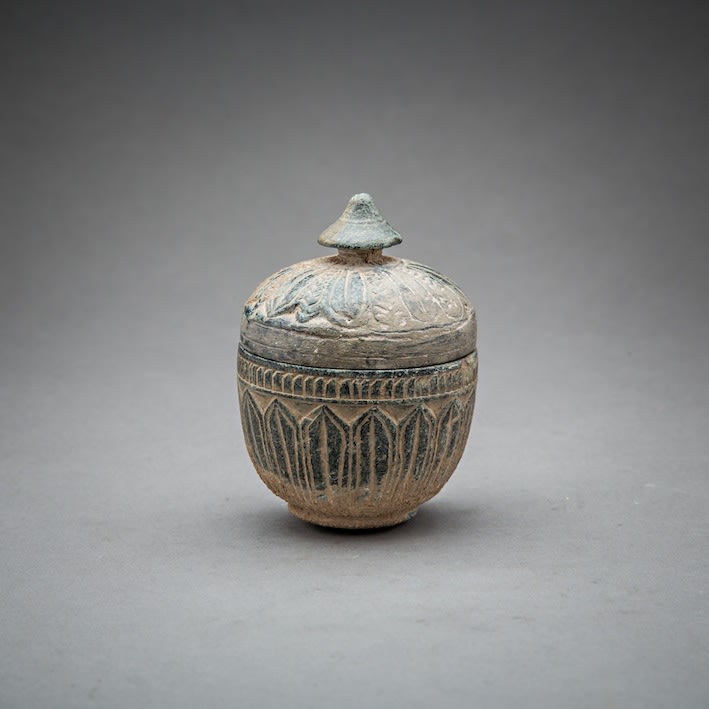Gandharan period Buddhist green schist reliquary, 1st Century CE - 5th Century CE
Schist
6.3 x 8.9 cm
2 1/2 x 3 1/2 in
2 1/2 x 3 1/2 in
LK.025
A reliquary is a container for holy relics. According to religious texts, the historical Buddha Shayamuni was cremated after his death and his ashes distributed between eight reliquaries. These were...
A reliquary is a container for holy relics. According to religious texts, the historical Buddha Shayamuni was cremated after his death and his ashes distributed between eight reliquaries. These were placed within eight hemispherical dome-shaped mounds known as stupas. In the 3rd century B.C. the north Indian ruler King Ashoka, is reputed to have opened these eigh monuments and further subdivided the ashes between a larger number of stupas. This was regarded as an act of great piety as it enabled many more believers to have access to the relics. Buddhism spread to Gandhara from the Ganges basin in northern India in the 2nd century B.C. In the following centuries many religious sites in Gandhara claimed to possess relics of the Buddha and they became important pilgrimage destinations, visited by devotees from all over Asia, especially China.
This vessel is designed as an independent small-scale monument and may have contained a relic as well as other small offerings such as glass beads or coins. Model stupas were also commissioned as reliquaries for the remains of eminent monks or Buddhist devotees. Such containers were often donated to monastic foundations by lay followers as a means to earn merit and generate good karma. It has an elegant design of stylized foliage on the lid. The small umbrella-like finial is a reference to the architecture of the stupas in which the original Buddha relics were stored. The stupas and in consequence such reliquaries were designed to reflect the order of the cosmos. The base was associated with the earthly sphere, whilst the ‘umbrellas’ symbolized the heavens. This remarkable object is carved from green schist, a material indigenous to the region and therefore popular with local carvers. As a physical manifestation of early Buddhist piety this object has important historical and religious associations.
For a similar example see, ‘The Art of Gandhara in the Metropolitan Museum of Art,’ (New York, 2007), p. 24, fig. 21.
This vessel is designed as an independent small-scale monument and may have contained a relic as well as other small offerings such as glass beads or coins. Model stupas were also commissioned as reliquaries for the remains of eminent monks or Buddhist devotees. Such containers were often donated to monastic foundations by lay followers as a means to earn merit and generate good karma. It has an elegant design of stylized foliage on the lid. The small umbrella-like finial is a reference to the architecture of the stupas in which the original Buddha relics were stored. The stupas and in consequence such reliquaries were designed to reflect the order of the cosmos. The base was associated with the earthly sphere, whilst the ‘umbrellas’ symbolized the heavens. This remarkable object is carved from green schist, a material indigenous to the region and therefore popular with local carvers. As a physical manifestation of early Buddhist piety this object has important historical and religious associations.
For a similar example see, ‘The Art of Gandhara in the Metropolitan Museum of Art,’ (New York, 2007), p. 24, fig. 21.



